
An atmospheric river will wind down through today across California with lingering heavy rainfall, heavy mountain snow, and gusty winds. A wintry mix of freezing rain, sleet, and snow will cause hazardous travel conditions for the Great Lakes into the northern Mid-Atlantic and southern New England today through Saturday morning. Areas of tree damage and power outages are possible. Read More >
Overview
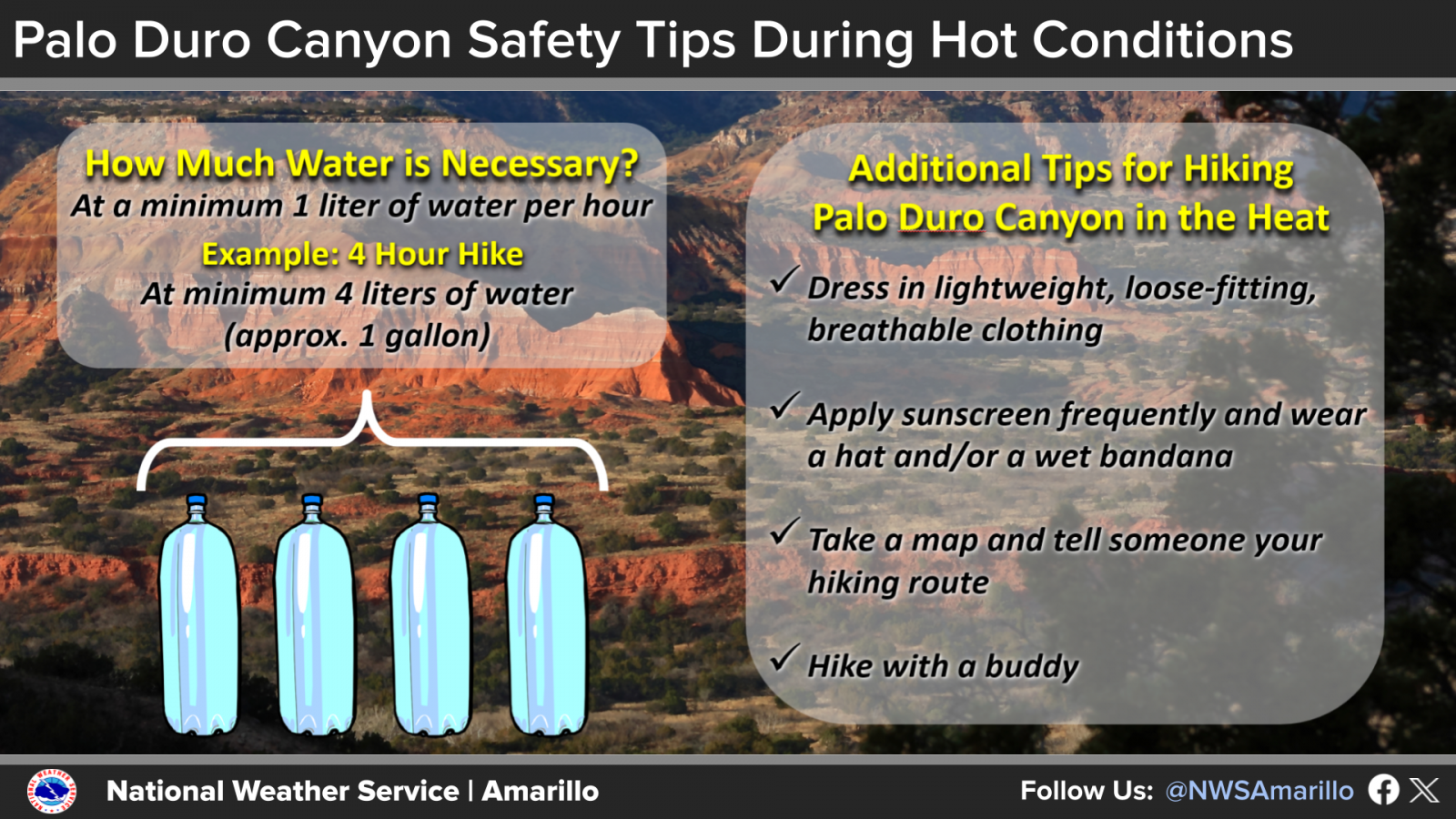 |
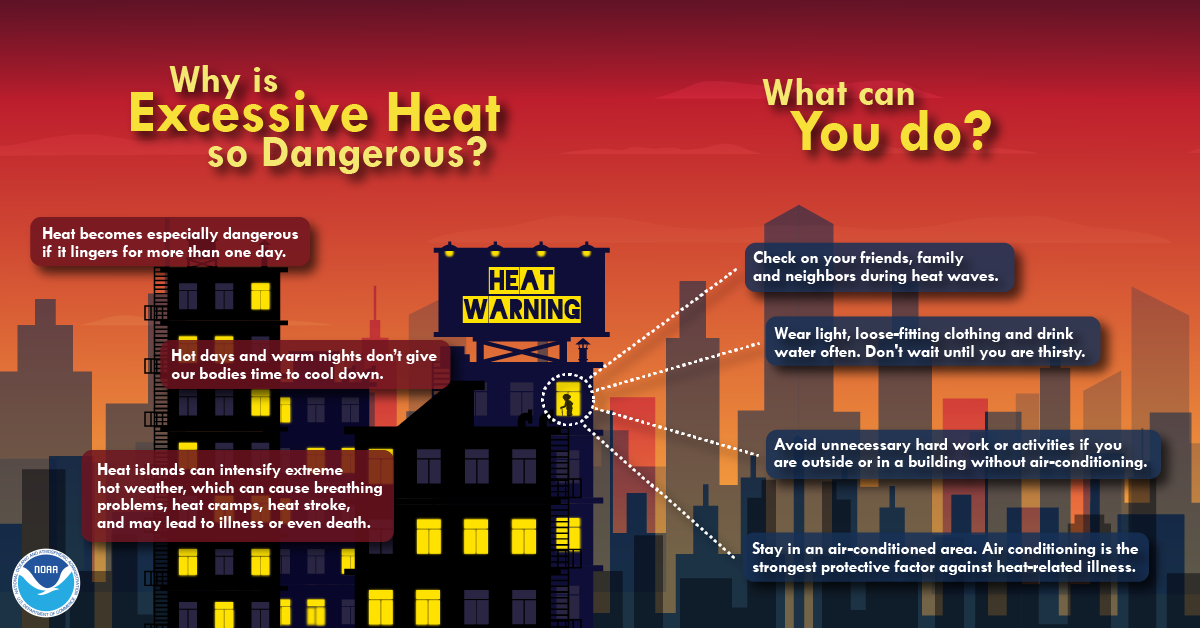 |
Heat can be a killer. The combination of hot weather and high humidity can quickly cause heat-related illness to set in. The National Weather Service issues advisories for high heat to warn you of the dangers. These alerts are issued when an extreme heat event is occurring, is imminent, or has a very high probability of occurrence.
NWS Amarillo Heat Products:
National Weather Service criteria for issuing heat-related products varies from region to region, is based on climatology of peak heat experienced, and adjusted in some areas due to public and core partner needs. Listed below are the heat-related products and their issuance criteria for the NWS Amarillo Weather Forecast Office:
An Extreme Heat Watch is issued when conditions are favorable for an extreme heat event in the next 12 to 48 hours. (>=50% chance) Meaning an Extreme Heat Warning is expected to be issued soon.
An Extreme Heat Warning is issued when an extreme heat event is likely to occur (>=80% chance) in the next 24 to 36 hours. A warning will be issued when there is high confidence that temperatures or heat indices will meet or exceed the following values:
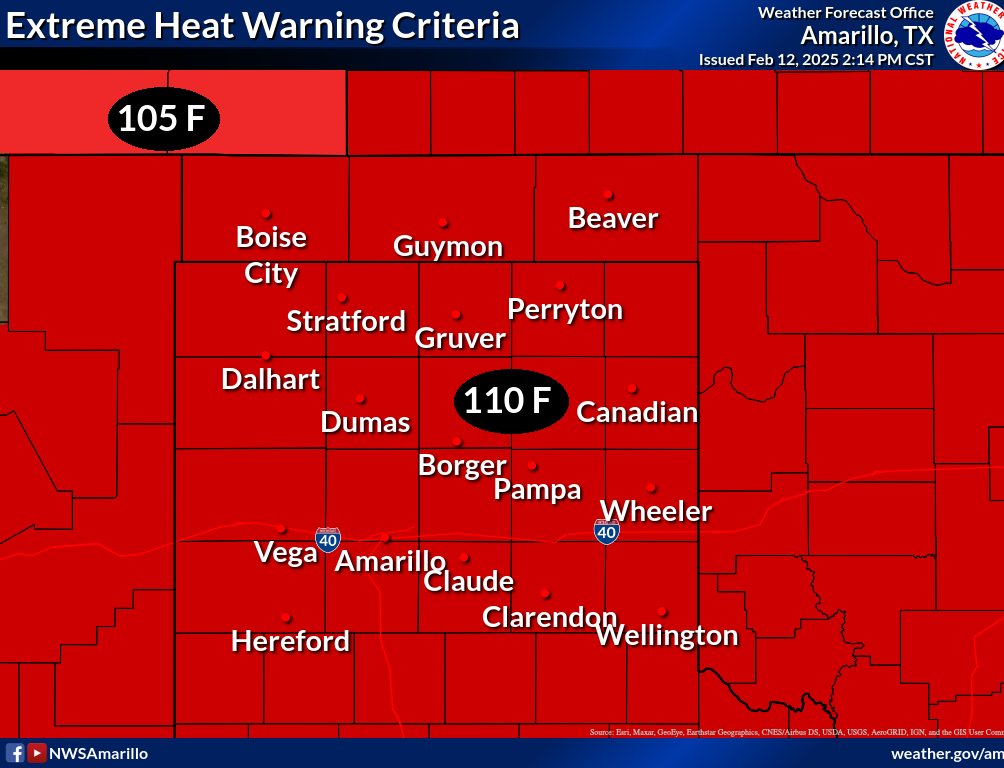
A Heat Advisory is issued when temperatures or heat indices are expected to meet the following criteria but stop short of Extreme Heat criteria above:
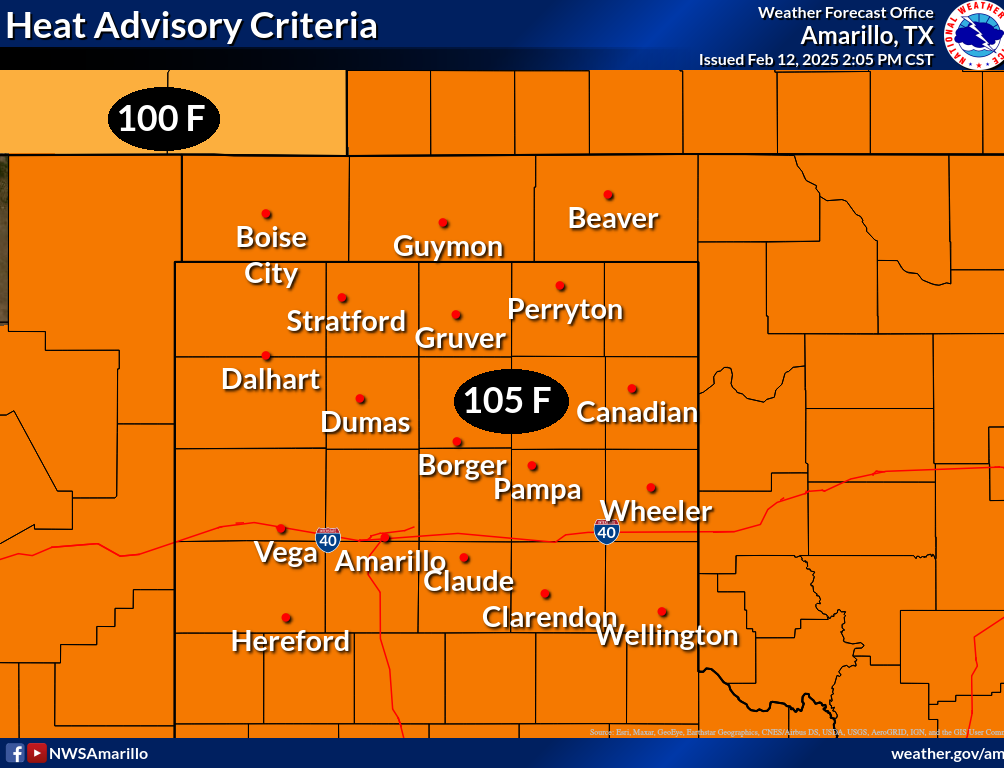
Heat Island Effect: Large urban cities, such as Amarillo, Borger, and Pampa, are equally at risk for a large number of heat deaths. People with few resources living in a highly urbanized area with the potential for long periods of high heat and humidity can be a deadly mix. The thresholds above could be lowered for prolonged heat waves, or the first heat event of the year as many people are not yet accustomed to the summer heat.
Heat Index
The NWS heat alerts are based on temperature as well as the heat index. The heat index takes into account humidity as well as temperature.
How to read the chart: find the temperature on the left hand side, then move to the right until you find the column for the approximate relative humidity. That number will be the temperature that it will "feel" like. Example: A temperature of 95 and relative humidity of 50% will "feel" like 107 degrees.
| 0% | 5% | 10% | 15% | 20% | 25% | 30% | 35% | 40% | 45% | 50% | 55% | 60% | 65% | 70% | 75% | 80% | |
| 115 | 103 | 107 | 111 | 115 | 120 | 127 | 135 | 143 | 151 | ||||||||
| 110 | 99 | 102 | 105 | 108 | 112 | 117 | 123 | 130 | 137 | 143 | 151 | ||||||
| 105 | 95 | 97 | 100 | 102 | 105 | 109 | 113 | 118 | 123 | 129 | 135 | 142 | 149 | ||||
| 100 | 91 | 93 | 95 | 97 | 99 | 101 | 104 | 107 | 110 | 115 | 120 | 126 | 132 | 136 | 144 | ||
| 95 | 87 | 88 | 90 | 91 | 93 | 94 | 96 | 98 | 101 | 104 | 107 | 110 | 114 | 119 | 124 | 130 | 136 |
| 90 | 83 | 84 | 85 | 86 | 87 | 88 | 90 | 91 | 93 | 95 | 96 | 98 | 100 | 102 | 106 | 109 | 113 |
| 85 | 78 | 79 | 80 | 81 | 82 | 83 | 84 | 85 | 86 | 87 | 88 | 89 | 90 | 91 | 93 | 95 | 97 |
| 80 | 73 | 74 | 75 | 76 | 77 | 77 | 78 | 79 | 79 | 80 | 81 | 81 | 82 | 83 | 85 | 86 | 86 |
| 75 | 69 | 69 | 70 | 71 | 72 | 72 | 73 | 73 | 74 | 74 | 75 | 75 | 76 | 76 | 77 | 77 | 78 |
| 70 | 64 | 64 | 65 | 65 | 66 | 66 | 67 | 67 | 68 | 68 | 69 | 69 | 70 | 70 | 70 | 70 | 71 |
IMPORTANT: Heat index values were devised for shady, light wind conditions. Exposure to full sunshine can increase values by up to 15 degrees! Also, strong winds, particularly with very hot, dry air, can be extremely hazardous.
Wet Bulb Globe Temperature
Extreme heat is a major weather-related hazard. Even a short period of exposure can be so taxing on the body that it results in a heat-related illness. Although outdoor physical activity may be unavoidable, heat-related illnesses and fatalities are preventable by using NWS forecast tools like Heat Index (which tells you how temperature feels to the human body in a shady area) or alternatively, Wet Bulb Globe Temperature (WBGT), before heading outside.
What is WBGT?
WBGT is an experimental forecast tool indicating expected heat stress on the human body when in direct sunlight. It estimates the effect of temperature, relative humidity, wind speed, and solar radiation on humans using a combination of temperatures from three thermometers:
With WBGT forecasts available by region up to 7 days in advance, it is a useful tool for planning ahead.
 |
Who should use WBGT?
This experimental tool is most useful for active, acclimatized people such as outdoor workers, athletes, and anyone else performing strenuous outdoor activities — and has been used for decades by military agencies, OSHA, and marathon organizers.
What should you do if WBGT deems outdoor activity dangerous?
Always follow the advice of your local officials before engaging in outdoor activities, as WBGT guidelines vary geographically since temperatures fluctuate by region and so does the body’s response to exercising or working in heat. OSHA recommends the following protective measures for outdoor workers:
Heat Injuries
| Heat Index | Possible heat disorders for people in higher risk groups |
| 130 or higher | Heatstroke/sunstroke highly likely with continued exposure. |
| 105-130 | Sunstroke, heat cramps or heat exhaustion likely, and heat stroke possible with prolonged exposure and/or physical activity. |
| 90-105 | Sunstroke, heat cramps and heat exhaustion possible with prolonged exposure and/or physical activity. |
| 80-90 | Fatigue possible with prolonged exposure and/or physical activity. |
| Heat Disorder | Symptoms | First Aid |
|---|---|---|
| Sunburn | Redness and pain. In severe cases swelling of skin, blisters, fever, and headaches. | Ointments for mild cases if blisters appear and do not break. If breaking occurs, apply dry sterile dressings. Serious, extensive cases should be seen by a physician. |
| Heat Cramps | Painful spasms usually in muscles of the legs and abdomen possible. Heavy sweating. | Firm presure on the cramping muscles, or gentle massaging to relieve the spasm. Give sips of water. If nausea occurs, discontinue use. |
| Heat Exhaustion | Heavy sweating, weakness, skin cold, pale and clammy. Pulse thready. Normal temperature possible. Fainting and vomiting. | Get victim out of sun. Lay down and loosen clothing. Apply cool, wet cloths. Fan or move victim to air conditioned room. Sips of water. If nausea occurs, discontinue use. If vomiting continues, seek immediate medical attention. |
| Heat Stroke (sunstroke) | High body temperature (106 F or higher). Hot dry skin. Rapid and strong pulse. Possible unconsciousness. | Heat stroke is a severe medical emergency. Summon emergency medical assistance or get the victim to a hosiptal immediately. Delay can be fatal.
Move the victim to a cooler environment. Reduce body temperature with cold bath or sponging. Use extreme caution. Remove clothing, use fans and air conditioners. If temperature rise again, repeat process. Do not give fluids. |
Heat Safety
Heat Index Forecast
Wet Bulb Globe Temperature Forecast (WBGT)
Click here for regional and national WBGT forecasts
See tabs below for WBGT through the next five days.
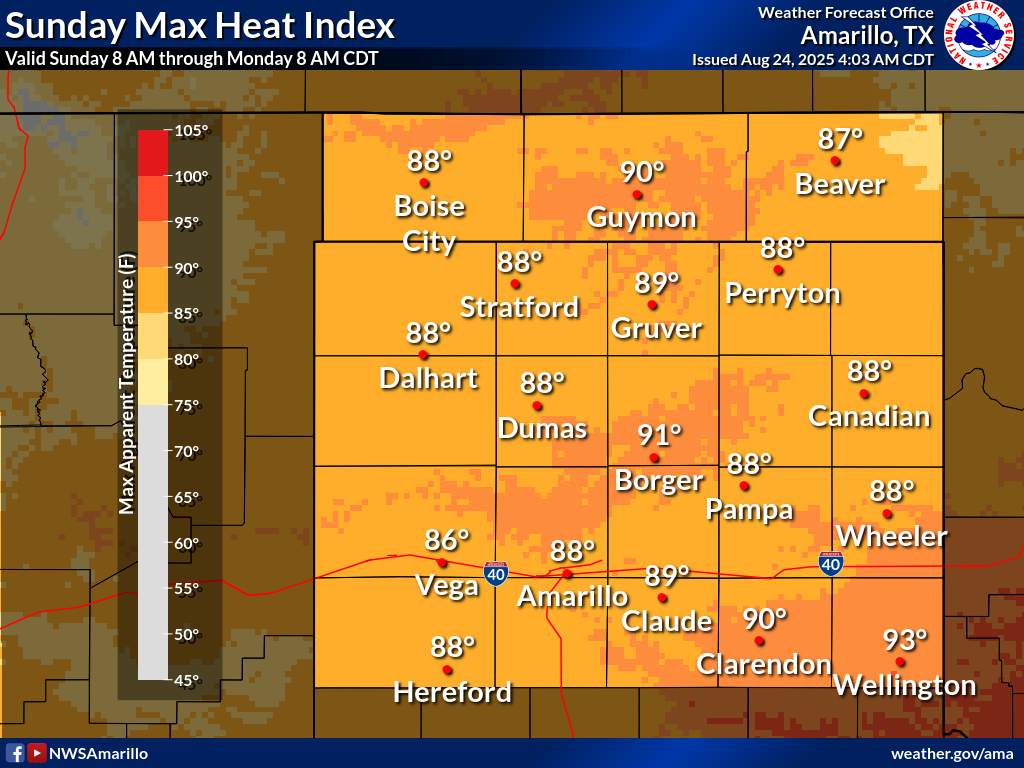
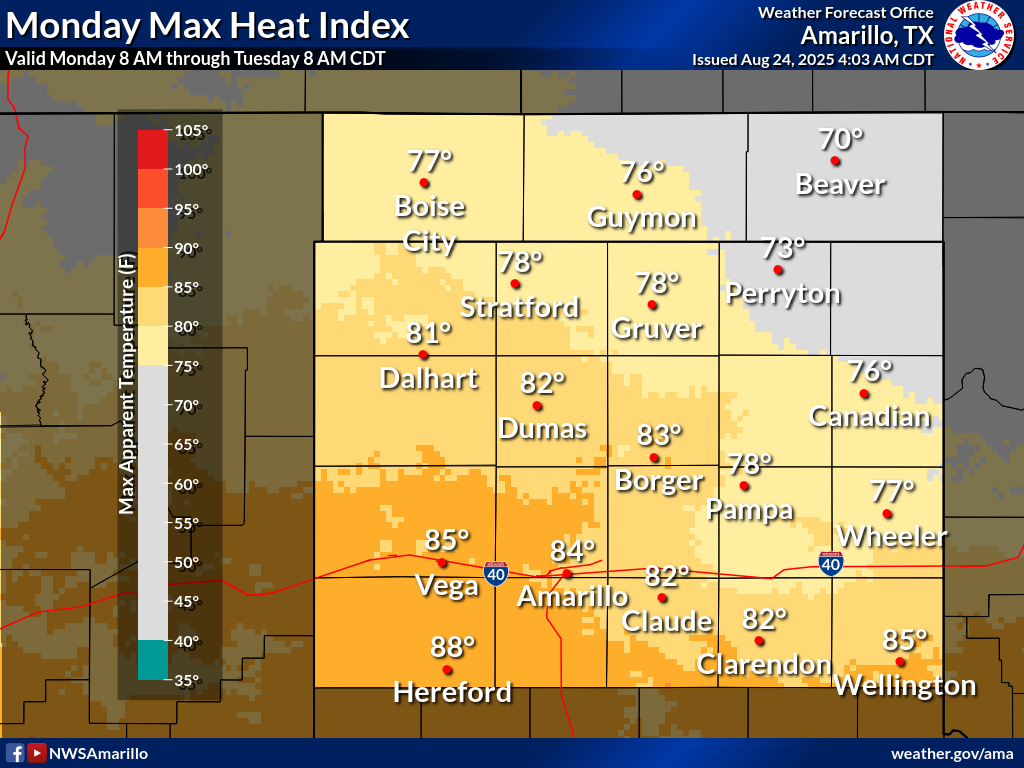
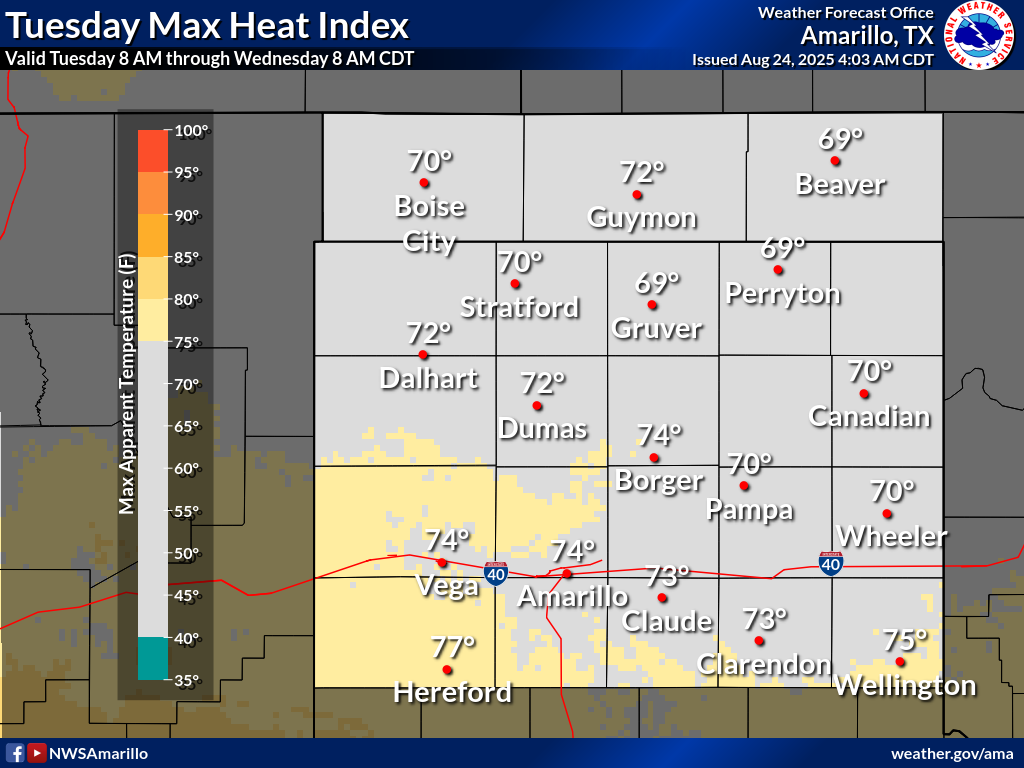
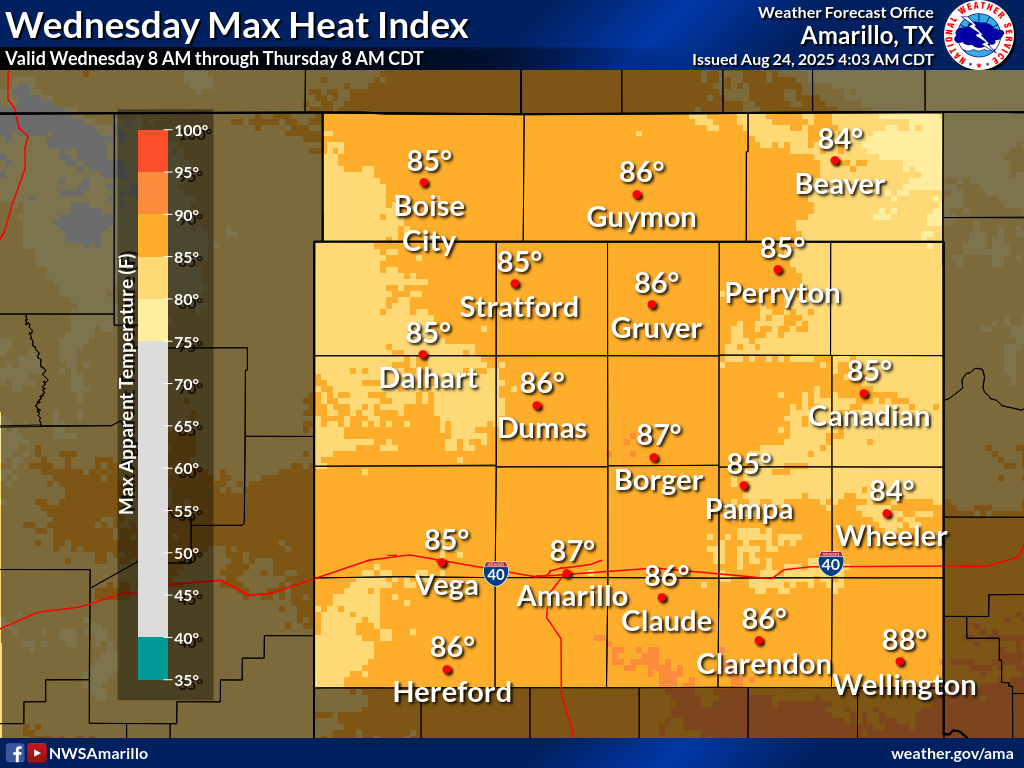
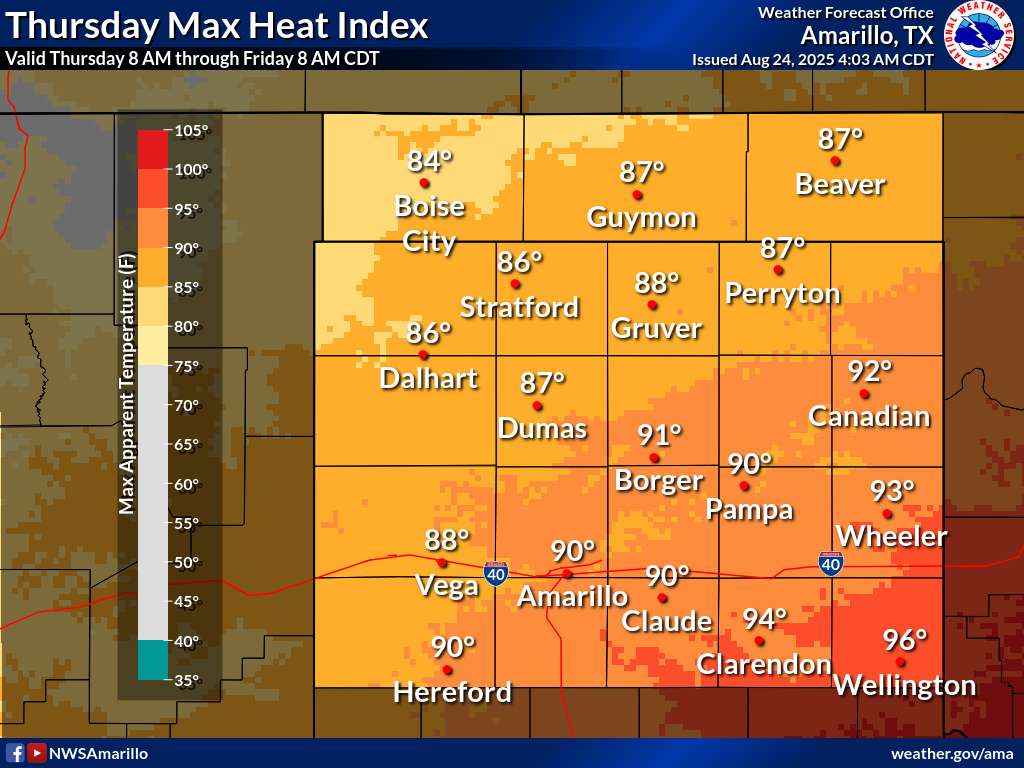
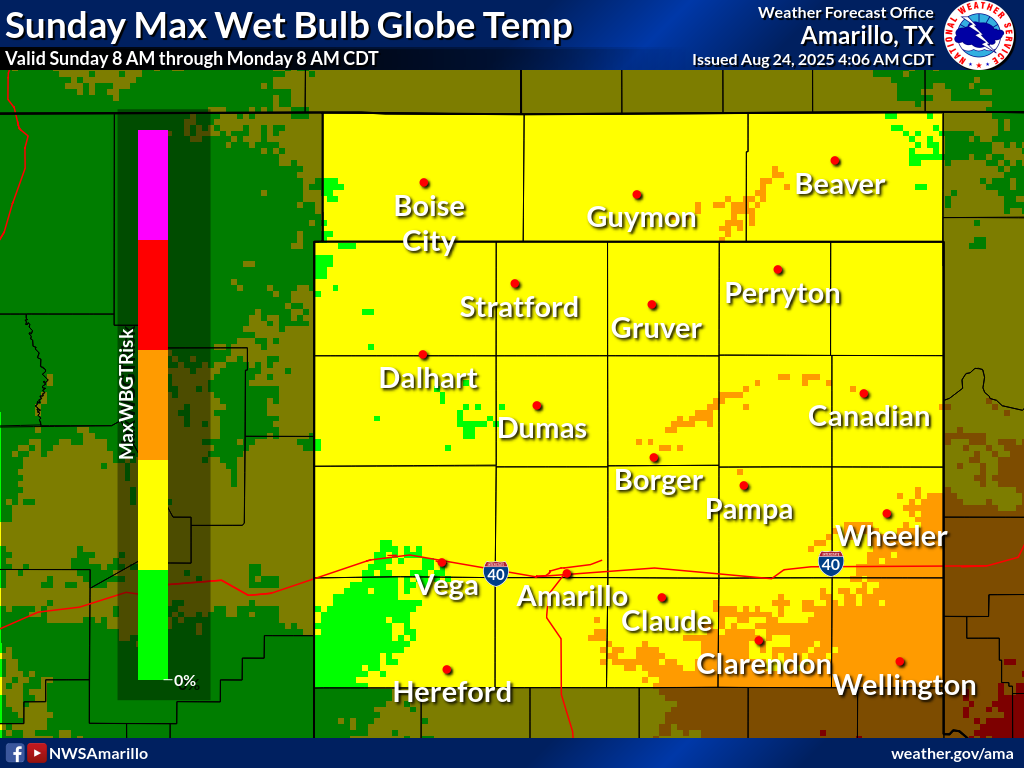
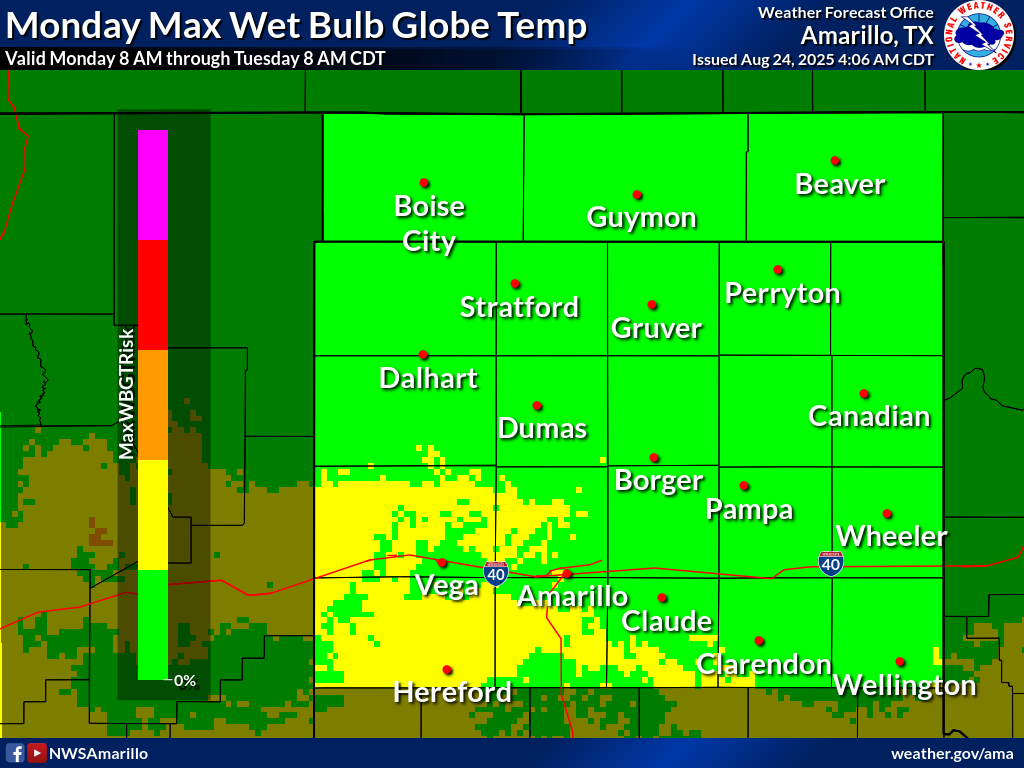
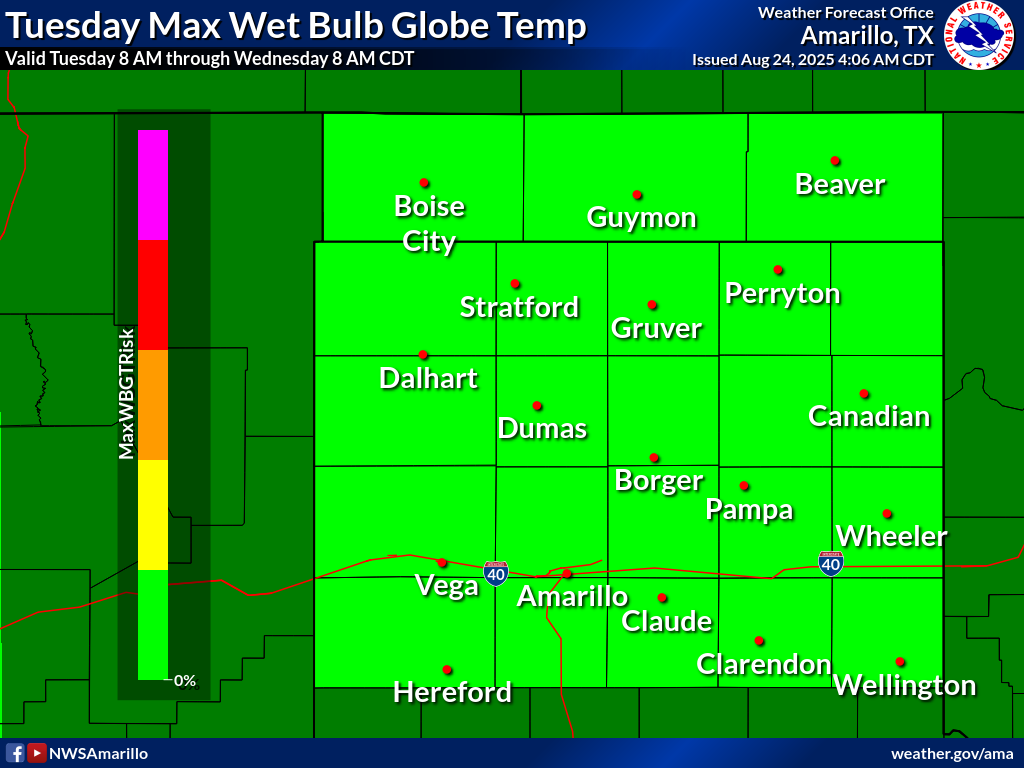
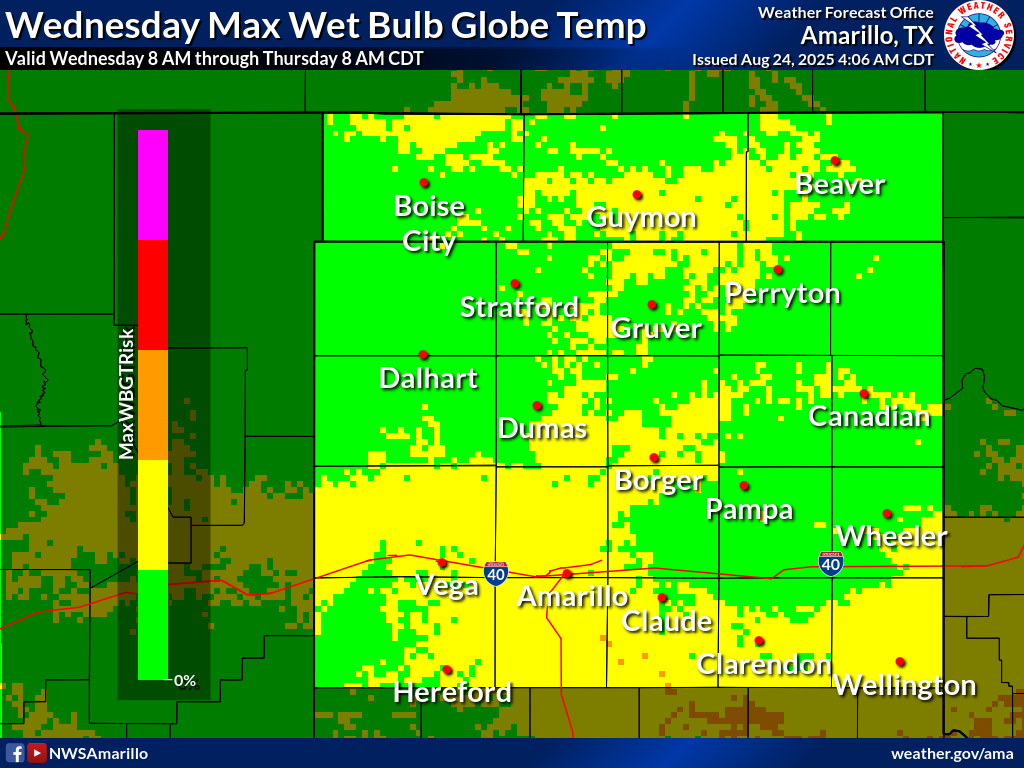
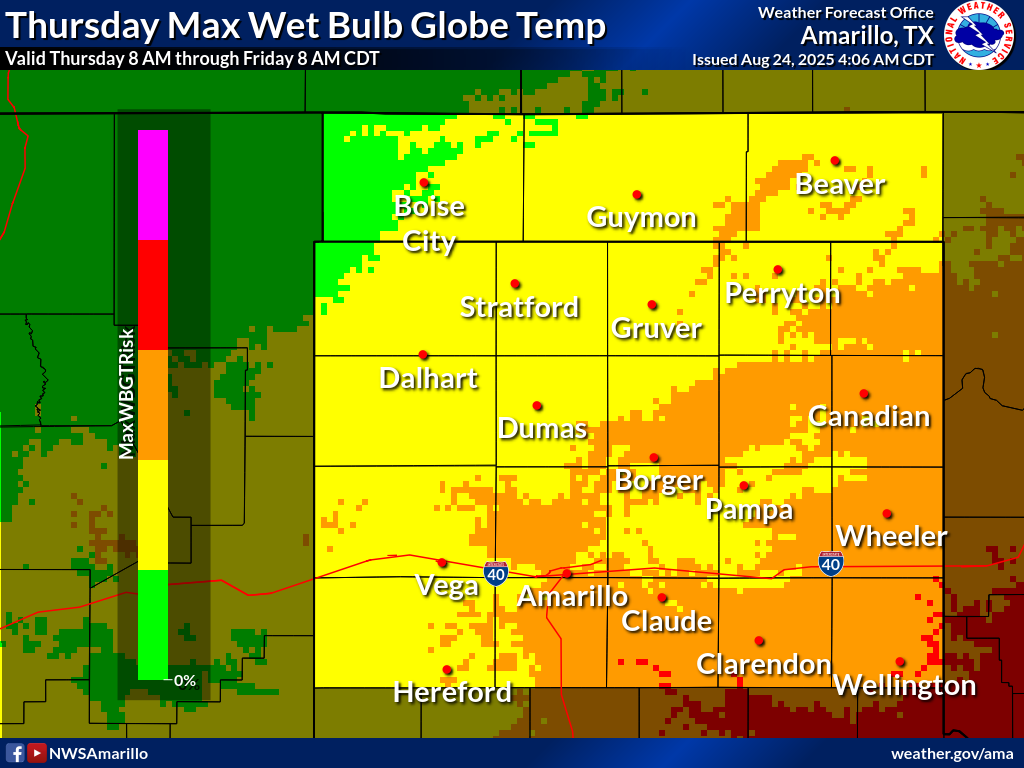
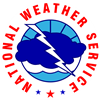 |
Media use of NWS Web News Stories is encouraged! Please acknowledge the NWS as the source of any news information accessed from this site. |
 |